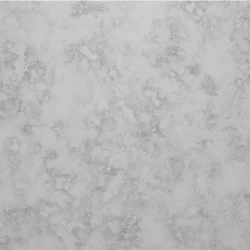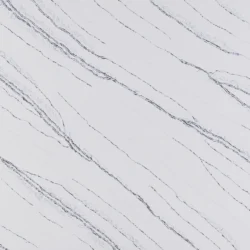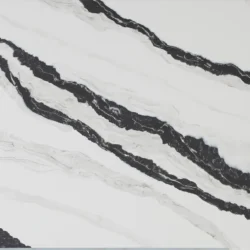

Welcome to the Tec Corp Stone Inc. Shop! Explore our extensive selection of premium stones, from elegant marble to durable granite. Whether you’re planning a renovation or a new build, find the perfect materials to elevate your space. Shop now for high-quality stones and bring your design dreams to life.
Quartz is a very hard engineered stone that consists of 90-92% natural quartz mineral and 8-10% resin, polymer and pigment. Quartz countertops are a great option for busy and busy kitchens, because the surfaces obtained from quartz stone are very resistant and stain-resistant. Also, quartz countertops are easy to clean with warm soapy water. We offer a wide variety of quartz stones, including: 5000 London gray slab, 5003 Pietra gray slab, 5043 Montblanc slab, 5100 Vanilla noir slab, 5101 Empira black slab, 5114 Calacatta maximus slab, 5131 Calacatta nuvo slab, 5151 Empira white slab, Alaska bianca slab, Alps slab, Angel g003 slab, Bianco carrara 3107 slab, C5126 venato carrara slab, Calacatta calabria evo t195 slab, Calacatta flux slab, Calacatta gold evo t105 slab, Calacatta musk slab, Dijon gold slab, Eternal marquina slab, Hawkins t128 slab, K1001 macchia gold slab, K1002 symphony gray slab, K1052 statuario venato slab, lucent Ciq4013 coral white slab, Lucent lq6713 tranquility white slab, Lucent lq6800 statuario oro slab, Lucent quartz ciq4211 bianco carrara slab, Lucent quartz lq4720 la lune slab, Lucent quartz lq5014 statuario nuvo slab, Lucent quartz lq5015 calacatta classico slab, Lucent quartz lq5131 calacatta slab, Mojave m006 slab, New amber gold x001 slab, Night warrior n006 slab, Phantom gray 3126 slab, Porto laurent slab, Q6101 calacatta gold slab, Q6109 imperial white slab, Q6114 lunar gray slab, Q6119 tranquility gold slab, Q6155 misty gray slab, Scandinavia slab, Taurus h004 slab, V8004 bianco nuvo slab, V8006 dove white slab, White shadow slab and Y9022 crystallo fog slab.
Showing 1–12 of 127 results







Quartz stone is one of the most popular materials used in interior design and decoration due to its beauty, durability, and wide range of colors. This stone is composed of crystalline silica (silicon dioxide) and is naturally found across the world.
The use of quartz dates back thousands of years. Ancient civilizations, such as the Egyptians and Romans, used this stone for making jewelry, decorative objects, and even sculptures. One of the main reasons for its popularity throughout history was its high hardness and unique luster, which made it easy to carve and shape.
In the 20th century, the quartz industry underwent significant advancements. With the development of technology, engineers succeeded in producing engineered quartz, a combination of natural quartz and polymer resins. This product, also known as synthetic quartz stone, revolutionized interior design. The reason for this was its superior resistance to stains, scratches, and heat compared to natural stone.
Today, quartz is one of the most sought-after stones for countertops, vanities, and flooring in homes and commercial spaces worldwide, including Canada. The demand for quartz continues to grow due to its versatility and the ability to customize colors and patterns. Leading brands such as Caesarstone, Silestone, and Cambria are at the forefront of this industry, offering a wide variety of products to meet different market needs.
In the following sections, we will explore the properties, advantages, disadvantages, maintenance methods, and applications of quartz stone.
Quartz is one of the most durable and abundant minerals on Earth, known for its exceptional hardness, chemical stability, and aesthetic appeal. These characteristics make it a highly desirable material in various industries, including construction, interior design, and even electronics.
Physical Properties of Quartz
Thanks to its unique combination of strength, stability, and aesthetic appeal, quartz is a top choice for both natural and engineered applications in modern design and technology.
Quartz is a highly versatile material widely used in interior design and construction due to its durability, aesthetic appeal, and low maintenance. Whether in its natural or engineered form, quartz enhances the functionality and elegance of residential and commercial spaces.
One of the most popular uses of quartz is in kitchen countertops. Engineered quartz is a top choice for homeowners and designers due to its non-porous surface, which resists stains, scratches, and bacterial growth. Unlike natural stones like granite or marble, quartz does not require sealing, making it a low-maintenance yet luxurious option.
Quartz is ideal for bathroom vanities and shower walls because it is water-resistant and easy to clean. The seamless appearance of engineered quartz provides a sleek, modern aesthetic while ensuring durability against moisture and humidity.
Quartz is used in flooring and wall cladding for both residential and commercial spaces. Its hardness ensures it can withstand heavy foot traffic, making it a great option for hotel lobbies, shopping malls, and office buildings. Additionally, quartz wall panels add a touch of elegance and luxury to interior spaces.
Thanks to its heat resistance, quartz is a great material for fireplace surrounds. It offers a stylish and contemporary alternative to traditional materials like brick or natural stone while being more customizable in terms of color and pattern.
Quartz backsplashes add a modern, polished look to kitchens and bathrooms. Unlike traditional tiles, large quartz slabs create a seamless, grout-free surface, reducing maintenance and enhancing visual appeal.
Quartz is widely used in commercial settings, such as restaurants, hotels, and office buildings, due to its durability, easy maintenance, and sophisticated appearance. Reception desks, conference tables, and bar tops made of quartz provide a professional and upscale look.
While natural quartz is commonly found in outdoor applications, engineered quartz is generally not recommended for outdoor use as prolonged exposure to UV rays may cause discoloration. However, in covered outdoor kitchens or patios, quartz can still be used effectively for countertops and bar tops.
With its combination of beauty, strength, and practicality, quartz remains one of the most sought-after materials in modern interior design and construction.
Quartz is a highly popular material in interior design and construction, offering a perfect blend of beauty, durability, and low maintenance. However, like any material, it has both advantages and disadvantages that homeowners and designers should consider before making a decision.
Quartz ranks 7 on the Mohs hardness scale, making it highly resistant to scratches, chips, and cracks. This makes it an excellent choice for high-traffic areas such as kitchen countertops and flooring.
Unlike natural stones like granite and marble, engineered quartz is non-porous, meaning it does not absorb liquids, stains, or bacteria. This makes it easy to clean and a more hygienic option for kitchens and bathrooms.
Quartz surfaces do not require sealing, polishing, or special treatments. Regular cleaning with mild soap and water is enough to maintain their shine, making them a low-maintenance choice for busy households.
Since engineered quartz is manufactured, it comes in a vast variety of colors, textures, and patterns, allowing for greater customization. It can even mimic the look of natural stones like marble or granite without the drawbacks.
Unlike natural stones, which may have inconsistent veining or patterns, quartz offers a more uniform and controlled look, making it ideal for modern and minimalist designs.
Quartz is heat-resistant to some extent, making it suitable for kitchen surfaces. However, it is always recommended to use trivets or heat pads to avoid direct exposure to extreme temperatures.
Many quartz brands use recycled materials and sustainable manufacturing processes, making it a more environmentally friendly choice compared to other stones that require extensive mining.
Although quartz is heat-resistant, the resin binders in engineered quartz can be damaged or discolored when exposed to direct heat above 150°C (300°F). Using hot pots and pans directly on the surface can cause thermal shock.
Quartz is generally more expensive than materials like laminate or tile. While it is often more affordable than high-end marble, its price can still be a significant investment for some homeowners.
Quartz slabs are very heavy, requiring professional installation and strong cabinetry support. DIY installation is usually not an option due to its weight and cutting requirements.
Unlike granite or other natural stones, engineered quartz is not UV-resistant. Prolonged exposure to sunlight can cause fading and discoloration, making it unsuitable for outdoor kitchens or exterior applications.
While quartz can imitate natural stone, some homeowners prefer the authentic variations, veining, and texture of real marble or granite. Since quartz is engineered, it may not have the same depth and uniqueness found in natural stone.
Quartz is an excellent choice for homeowners looking for a durable, low-maintenance, and stylish surface. Its non-porous nature, stain resistance, and variety of design options make it one of the top choices for modern kitchens and bathrooms. However, it does have some limitations, such as heat sensitivity and lack of outdoor suitability.
For those who prioritize convenience, hygiene, and long-lasting beauty, quartz remains one of the best investments in interior design and construction.
When choosing a surface material for countertops, flooring, or wall cladding, homeowners and designers often compare quartz with other natural and engineered stones. Below is a detailed comparison between quartz and its main competitors: granite, marble, quartzite, porcelain, onyx, and soapstone.
| Feature | Quartz | Granite |
| Material Type | Engineered | Natural |
| Durability | Very high (scratch & stain-resistant) | Very durable but porous |
| Maintenance | Low (no sealing required) | Requires sealing to prevent stains |
| Porosity | Non-porous (resists bacteria & stains) | Porous (can absorb liquids) |
| Heat Resistance | Moderate (can discolor under high heat) | High (heat-resistant) |
| Appearance | Consistent, available in many colors & patterns | Natural veining, each slab is unique |
| Price | Mid to high range | Mid to high range |
Verdict: Quartz is easier to maintain and more stain-resistant, while granite offers a more natural and unique look.
| Feature | Quartz | Marble |
| Material Type | Engineered | Natural |
| Durability | High (resistant to scratches and impact) | Soft, prone to scratches & chips |
| Porosity | Non-porous (no staining) | Highly porous (absorbs liquids, stains easily) |
| Maintenance | Low (no sealing required) | High (needs frequent sealing & special care) |
| Heat Resistance | Moderate (can discolor under extreme heat) | Heat-resistant but can etch with acids |
| Appearance | Consistent, available in many colors | Elegant, natural veining |
| Price | Mid to high range | High-end, expensive |
Verdict: Marble is luxurious but requires high maintenance, whereas quartz mimics marble’s look while being more durable and easier to care for.
| Feature | Quartz | Quartzite |
| Material Type | Engineered | Natural |
| Durability | High (scratch & impact-resistant) | Very high (stronger than marble, but needs sealing) |
| Porosity | Non-porous | Porous (requires sealing) |
| Maintenance | Low (easy to clean) | Medium (needs regular sealing) |
| Heat Resistance | Moderate | High (resists high temperatures) |
| Appearance | Uniform patterns and colors | Natural, unique veining |
| Price | Mid to high range | High range |
Verdict: Quartzite is more natural and heat-resistant, but quartz is easier to maintain and offers more design variety.
| Feature | Quartz | Porcelain |
| Material Type | Engineered | Engineered (ceramic-based) |
| Durability | Very high | Extremely high (resistant to scratches, stains, and heat) |
| Porosity | Non-porous | Non-porous |
| Maintenance | Low (easy to clean) | Very low (no sealing required) |
| Heat Resistance | Moderate | Excellent (high heat-resistant) |
| Appearance | Consistent, customizable | Available in many colors and patterns, can mimic stone or wood |
| Price | Mid to high range | Mid to high range |
Verdict: Porcelain is even more heat-resistant and scratch-proof than quartz but can be prone to chipping on edges. Quartz offers a more natural stone-like feel.
| Feature | Quartz | Onyx |
| Material Type | Engineered | Natural |
| Durability | High | Fragile, easily scratched |
| Porosity | Non-porous | Very porous (absorbs liquids easily) |
| Maintenance | Low | High (requires sealing and delicate care) |
| Heat Resistance | Moderate | Low (can be damaged by heat) |
| Appearance | Uniform and customizable | Translucent, luxurious, unique patterns |
| Price | Mid to high range | High to very high |
Verdict: Onyx is visually stunning and luxurious but requires careful maintenance, while quartz is far more practical for daily use.
| Feature | Quartz | Soapstone |
| Material Type | Engineered | Natural |
| Durability | High | Softer, can scratch and dent easily |
| Porosity | Non-porous | Non-porous but darkens over time |
| Maintenance | Low | Medium (requires oiling for upkeep) |
| Heat Resistance | Moderate | Excellent (highly heat-resistant) |
| Appearance | Wide variety of colors | Dark, rich look with natural aging |
| Price | Mid to high range | High range |
Verdict: Soapstone is heat-resistant and develops a natural patina, while quartz is more durable and requires less maintenance.
Quartz remains one of the most practical choices for modern homes due to its durability, low maintenance, and aesthetic flexibility, making it an ideal investment for kitchen countertops, bathroom vanities, and commercial spaces.
The cost of quartz countertops in Canada varies based on several factors, including the quality and brand of the quartz, the dimensions and thickness of the slab, design complexity, and installation charges. Here’s a detailed breakdown:
Reputable brands offering high-quality quartz typically come at a higher price point. These brands often provide unique features such as exclusive designs, enhanced durability, and extended warranties.
Larger and thicker quartz slabs generally increase the overall cost. Standard thicknesses for quartz countertops are usually 2 or 3 centimeters.
Intricate designs, special edge profiles, and custom cutouts (e.g., for under-mount sinks or cooktops) can elevate installation costs. Additional features like backsplashes or waterfall edges also contribute to the total expense.
Installation fees vary depending on geographic location, the experience of the installer, and the project’s complexity. Professional installation ensures the countertop’s longevity and aesthetic appeal.
Considering the factors above, the average price for quartz countertops in Canada, including materials and installation, typically ranges between $70 to $120 CAD per square foot. For instance, for a kitchen with 50 square feet of countertop space, the total cost might range from $3,500 to $6,000 CAD.
Note: These figures are approximate. For precise pricing, it’s advisable to consult local suppliers and installers.
By considering these aspects, you can make a well-informed choice that aligns with your budget and meets your specific requirements.
Quartz countertops are known for their durability, non-porous surface, and low-maintenance qualities, making them an excellent choice for kitchens and bathrooms. However, to keep them looking their best, proper care and maintenance are essential. Below are key guidelines to help preserve the beauty and longevity of quartz surfaces.
Quartz is stain-resistant but still requires regular cleaning to maintain its shine.
✔ Use mild soap and water – A soft cloth or sponge with warm water and a few drops of dish soap is sufficient for everyday cleaning.
✔ Use a non-abrasive cleaner – If needed, choose a pH-balanced quartz cleaner to remove dirt and grime.
✔ Wipe spills immediately – Even though quartz is non-porous, prolonged exposure to acidic or pigmented substances (like wine, coffee, or lemon juice) can dull the finish.
Harsh cleaning agents can damage the quartz surface over time.
Avoid bleach and strong chemicals – Highly acidic or alkaline cleaners can break down the resin in engineered quartz.
Do not use abrasive pads or scouring sponges – They can scratch or dull the surface.
Stay away from oven cleaners and paint removers – These contain harsh chemicals that can permanently damage the countertop.
Recommended Alternative: If you need a stronger cleaner, use a diluted vinegar solution (one part vinegar to three parts water) but avoid prolonged exposure.
While quartz is heat-resistant, it is not heat-proof.
✔ Always use trivets and hot pads – Placing hot pans, pots, or baking trays directly on the surface can cause discoloration or damage the resin.
✔ Avoid direct heat exposure – Quartz can withstand temperatures up to 150°C (300°F), but sudden temperature changes (thermal shock) can lead to cracking.
✔ Be cautious with heavy objects – Dropping heavy kitchen appliances or tools on the surface can cause chips or cracks.
Quartz is resistant to stains, but some substances may require extra care.
For dried spills – Use a plastic scraper or a soft cloth with a mild cleaner to gently remove dried food or grease.
For tough stains – Apply a small amount of isopropyl alcohol (rubbing alcohol) on a microfiber cloth and wipe the affected area.
For ink or marker stains – A small amount of baking soda mixed with water can help lift stains, but avoid excessive scrubbing.
Quartz countertops naturally have a glossy finish, but improper care can make them look dull.
✔ Use a microfiber cloth – Regularly wiping with a microfiber cloth helps maintain the luster.
✔ Avoid wax or polish – Unlike natural stones, quartz does not need polishing or sealing.
✔ Clean with a vinegar solution (sparingly) – Occasional use can help restore shine but should not be done too often.
Though quartz is highly resistant to stains, prolonged exposure to certain elements can cause discoloration.
Avoid prolonged UV exposure – Quartz is not UV-resistant, so outdoor use or exposure to direct sunlight for extended periods can cause fading.
Be cautious with strong dyes and chemicals – Household chemicals like nail polish remover, hair dye, or strong oils can cause discoloration if not wiped away immediately.
By following these simple care and maintenance tips, you can extend the life and beauty of your quartz countertops for years to come. Regular cleaning, avoiding harsh chemicals, and protecting against heat and impact are the best ways to keep quartz surfaces looking as good as new.
n Canada, quartz has emerged as a leading choice for interior surfaces, particularly in kitchens and bathrooms. Its popularity stems from a combination of durability, aesthetic appeal, and ease of maintenance. Here’s an overview of the trends and reasons behind the widespread adoption of quartz in Canadian homes:
Quartz offers a vast array of colors and patterns due to its engineered production process. This variety allows homeowners and designers to select surfaces that perfectly align with their interior décor preferences. From marble-like veining to bold, contemporary hues, quartz caters to a wide range of tastes.
One of the primary reasons for quartz’s popularity is its high resistance to scratches, stains, and heat. This makes it an ideal choice for high-traffic areas like kitchens. Additionally, quartz surfaces do not require periodic sealing, simplifying maintenance routines.
Unlike some natural stones that may have inconsistencies or color variations, quartz provides a uniform and flawless look. This consistency is particularly appealing in modern and minimalist designs where a sleek, cohesive appearance is desired.
Many Canadian quartz manufacturers prioritize sustainability by incorporating recycled materials and adopting eco-friendly production methods. This commitment appeals to environmentally conscious consumers seeking sustainable home improvement options.
The presence of esteemed quartz brands in the Canadian market provides consumers with confidence in product quality and durability. These brands often offer extended warranties and robust customer support, enhancing trust and satisfaction.
Quartz’s adaptability allows it to complement various design aesthetics, from classic to contemporary. This flexibility makes it a favored choice among interior designers and architects aiming to achieve specific stylistic goals.
In summary, the fusion of technical excellence and diverse aesthetic options has solidified quartz’s status as a top choice for interior surfaces in Canada.
Selecting the right quartz countertops involves more than just picking a color or pattern. To ensure the best choice for your home, consider the following key factors:
Not all quartz countertops are created equal. The quality can vary based on the manufacturer and the materials used.
✔ Choose reputable brands – Established brands often provide better durability, warranties, and a more consistent finish.
✔ Check for certifications – Look for Greenguard or NSF certifications to ensure the quartz is safe and meets industry standards.
Quartz countertops come in a wide variety of designs, from solid colors to marble-like veining.
✔ Match with your décor – Choose a color and pattern that complement your kitchen or bathroom design.
✔ Matte vs. polished finish – A polished finish gives a shiny, reflective look, while a matte (honed) finish provides a softer, more natural appearance.
Quartz countertops are typically available in 2 cm (¾ inch) and 3 cm (1¼ inch) thicknesses.
✔ 3 cm thickness is more durable – It requires no extra support and offers a high-end, substantial look.
✔ 2 cm thickness is lightweight – It may require plywood backing but can be cost-effective.
✔ Edge styles matter – Options like straight, beveled, bullnose, or waterfall edges can enhance the aesthetic appeal.
One of the biggest advantages of quartz is its low maintenance requirements. However, you should still consider:
✔ Scratch and stain resistance – Quartz is highly resistant, but light-colored surfaces can show stains more easily.
✔ Heat resistance – While quartz withstands heat, it is not heat-proof. Always use trivets or heat pads.
✔ Easy cleaning – Use mild soap and water for daily cleaning and avoid harsh chemicals.
Quartz is an investment, so it’s important to set a budget before making a decision.
✔ Price range – Quartz countertops in Canada typically cost $70–$120 CAD per square foot, including installation.
✔ Installation complexity – Custom designs, cutouts, and special edge finishes can increase labor costs.
A good warranty is a sign of high-quality quartz and reliable service.
✔ Look for a long-term warranty – Many top brands offer 10-year to lifetime warranties.
✔ Check the fine print – Some warranties only apply to original buyers or require professional installation.
By considering quality, design, durability, budget, and warranties, you can confidently choose a quartz countertop that enhances your space and lasts for years. If you need help selecting the best quartz for your home, consulting a professional supplier in Canada is always a great option!

At Tec Corp Stone Inc., we pride ourselves on delivering exceptional craftsmanship and unmatched quality. With years of experience in stone fabrication, our dedicated team ensures every project is executed with precision and care. We offer personalized service, innovative solutions, and a commitment to customer satisfaction. Choose us for your stone needs and experience the Tec Corp Stone Inc. difference.